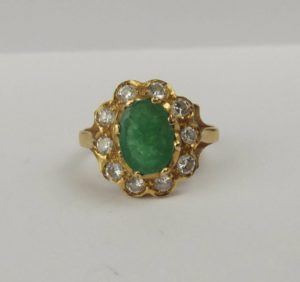~ Meiji Period (19th Century Japanese) Lobed and Decorated Bronze Jardinière ~
This is a handsome planter or jardinière cast in bronze by the “lost wax” method, with lobed panels decorated in high relief.
The ornamentation features cherry branches, with buds bursting into blossom and busy sparrows or “chidori” in flight and chattering to each other. Meanwhile, long-tailed birds called Japanese paradise-flycatchers perch and twist on the limbs of the tree. Their poses suggest animation to express the high activity that springtime brings.
While the vessel’s exterior is rich with decoration, the interior is plain, except for a coin-sized detail which we think might well be the maker’s mark and address, the characters Nichi and Hon are present which combined mean “Nippon”.
There is a hidden panel on the base of the planter which shows cranes amongst bamboo with two characters we can’t translate, perhaps a signature, or maybe a title for the springtime themed collection this piece was part of.
A good generous size, and artfully handmade, this is a typical piece of Meiji artwork, demonstrating the artistic styles of the time and showcasing the refined talents of Japan’s craftsmen to the wider world.
Seen similar at twice the price.
~ The Meiji Era ~
In 1868 the restoration of imperial rule in Japan brought the Edo shogunate to an end, and marked the start of the Meiji era, which would last until the death of Emperor Meiji in 1912. During this brief period the country experienced radical social and political shifts, and a host of reforms which propelled Japan – closed to international trade for more than 200 years – from feudalism into modernity.
The profound impact of the country’s new engagement with foreign cultures is evident in many areas of Meiji-period art, which reflected a new era for the nation and its art being introduced to the international stage.
~ Dimensions ~
The jardiniere has a height of 11 inches (28 cm) and a diameter of 14 inches (36 cm) at its widest.
Its mouth has a width of 11 inches (28 cm) and the weight of the piece is 6.21 kg.
~ Condition ~
On the whole, the piece is in good shape and has no dents or cracks, it has one very minor dink to the edge of the base (pictured).
Two of the long-tailed birds each have had a wing-tip broken off (also pictured), but both sites of damage sit within 3 of the 14 lobes and so could be easily concealed if placed beside a wall (the rich decoration encircles the entire piece).
Evidently used by a previous user to grow a plant in, the interior shows signs of verdigris and 3 tiny (2 mm) holes that are virtually undetectable from the outside, certainly without very close scrutiny.
#7679




























